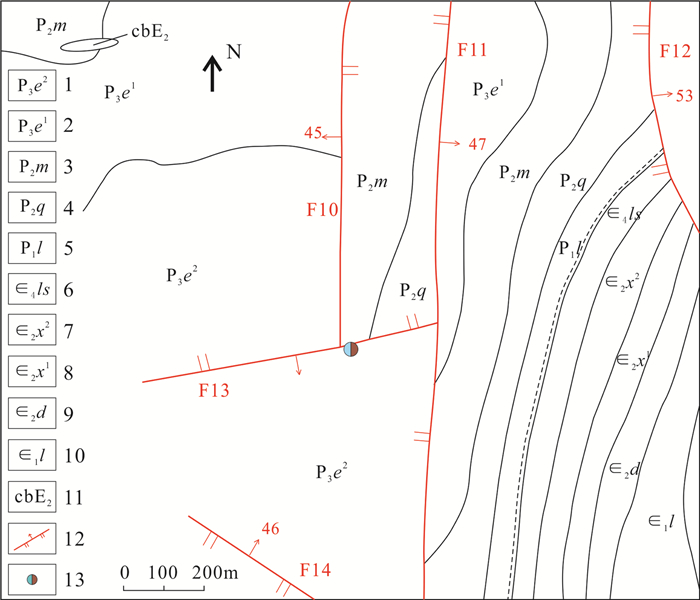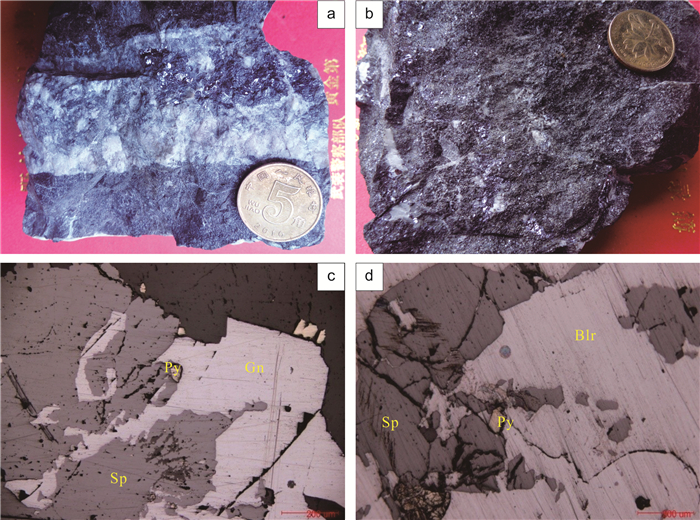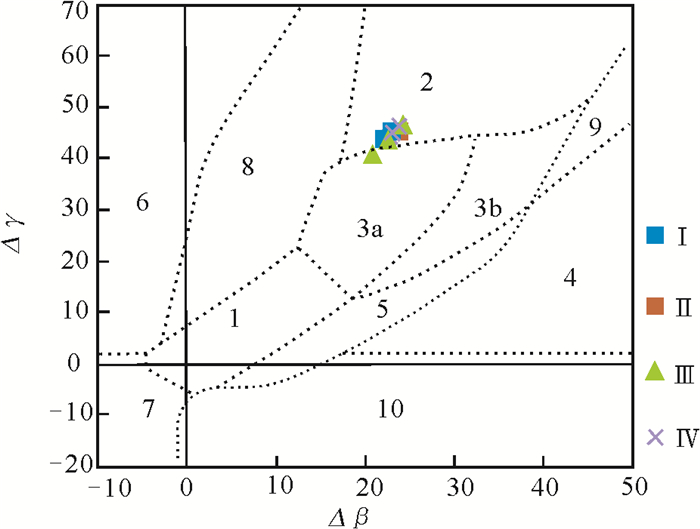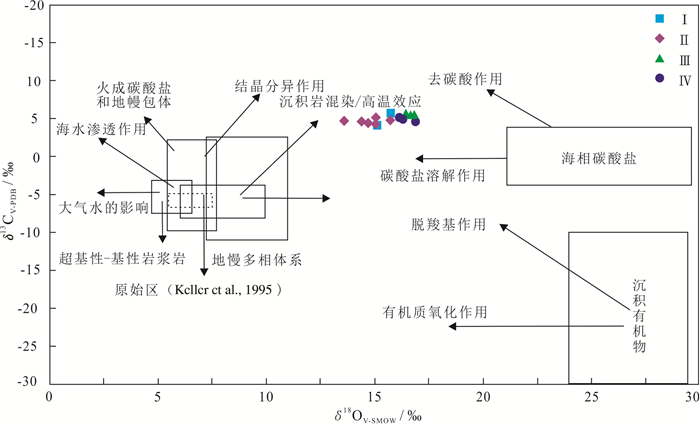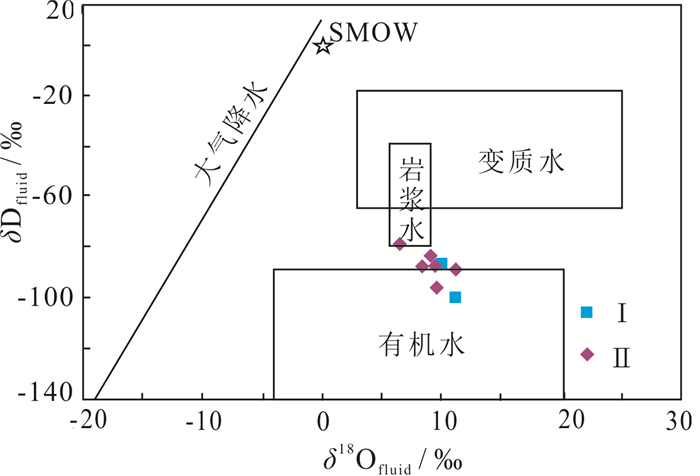Sources of Permian lead-zine ore-forming materials in Sichuan-Yunnan-Guizhou area: C-H-O-S-Pb isotope constraints——An example from Taipingzi lead-zinc deposit in Yunnan Provinces
-
摘要:研究目的
川滇黔地区铅锌矿成因具有多样性,特别是与峨眉山玄武岩的关系存在较大的争议,本文从前人关注较少的二叠系碳酸盐岩中的铅锌矿入手,研究成矿物质来源。
研究方法以云南寻甸县太平子铅锌矿为研究对象,运用S、Pb、C、H、O同位素实验数据及流体包裹体测温等方法,对成矿物质来源及成矿流体特征进行探讨。
研究结果矿石铅同位素组成比较均一,分布集中,206Pb/204Pb、207Pb/204Pb、208Pb/204Pb的变化范围分别为18.543~18.584、15.646~15.694、38.799~38.958,属于正常普通铅,具壳源特征,主要来源于基底岩石,水岩反应可能使赋矿围岩贡献少量的成矿物质。矿石硫化物δ34S变化范围为-13.6‰~-7.3‰,方铅矿的δ34S高于闪锌矿,硫同位素分馏并未达到平衡,生物成因硫酸盐还原作用(BSR)是还原硫的主要来源。热液方解石δ13CV-PDB范围为3.8‰~4.7‰,δ18OV-SMOW范围为12.0‰~16.7‰,相较于滇东北其他重要的铅锌矿床,具有明显的低δD、高δ18Ofluid特点,成矿流体中的水主要来源于岩浆水和有机水的混合,具有中—高温、低盐度特征。
结论太平子铅锌矿在成矿物质、流体、成矿温度等均与区域上其他典型铅锌矿有较明显差别,具有典型的岩浆-热液成因特点。
Abstract:This paper is the result of the geological survey engineering.
ObjectiveThe genesis of Pb-Zn deposit in Sichuan, Yunnan and Qianhai is diverse, especially the relationship with the Emei Mountain basalt is more controversial. In this paper, we study the source of ore-forming material, starting from Pb-Zn deposit in Permian carbonate rocks, which has received less attention from previous authors.
MethodsUsing experimental data of S, Pb, C, H, and O isotopes and fluid inclusion temperature measurements, the source of mineralized materials and the characteristics of mineralized fluids were investigated in the Taipingzi Pb-Zn deposit in Xundian County, Yunnan Province.
ResultsThe Pb isotopic compositions of the ore are relatively homogeneous and concentrated, with the variations of 206Pb/204Pb, 207Pb/204Pb and 208Pb/204Pb ranging from 18.543 to 18.584, 15.646 to 15.694 and 38.799 to 38.958, respectively. These suggest that the Pb in Taipingzi Pb-Zn deposit belongs to normal common Pb with crustal origin. The metal-forming materials are mainly from the basement rocks, and the water-rock reaction may make the mineralized enclosing rocks contribute a small number of mineralized materials. The δ34S in ore sulfide varies from -13.6 ‰ to -7.3 ‰ and δ34S of the galena is higher than that in sphalerite. Sulfur isotope fractionation has not reached equilibrium, sulfur is mainly from crustal source. Biogenic sulfate reduction (BSR) is the main mechanism of sulfur reduction. A large amount of biogenic sulfur reduction has accumulated in the mineralized area before mineralization. The hydrothermal calcite δ13CV-PDB ranges from 3.8 ‰ to 4.7‰ and δ18OV-SMOW ranges from 12.0 ‰ to 16.7 ‰ with obvious low δD and high δ18Ofluid characteristics compared to other important Pb-Zn deposits in northeast Yunnan. The water in the mineralizing fluid mainly originates from a mixture of magmatic and organic water, with medium-high temperature and low salinity characteristics.
ConclusionsTaipingzi Pb-Zn deposit is significantly different from other typical Pb-Zn ores in the region in terms of metallogenic material, fluids and metallogenic temperature, and has typical magmatic-hydrothermal genesis characteristics.
-
1. 引言
川滇黔铅锌多金属成矿区是中国重要银铅锌多金属成矿带之一,具有良好的成矿地质背景和控矿条件。该区铅锌矿成因类型观点多样,主要有:岩浆-热液成因、沉积成因、沉积-改造成因、后生-外源成因、沉积-成岩期后热液改造-叠加成因、MVT型矿床、热液喀斯特成因、沉积-改造-后成成因、海底热水沉积-叠加改造型成因、“深部流体贯入-环流萃取地层(蒸发岩层)-构造控制成矿”成矿模式和均一化成矿流体贯入成因等。
在成矿物质来源方面,多趋向于“多来源”的观点。早期学者认为成矿物质由碳酸盐地层和玄武岩提供(廖文,1990;陈进,1993;柳贺昌,1996);李连举等(1999)提出上震旦统—下寒武统、石炭系和中、上泥盆统是区域重要的矿源层,寒武系中统碳酸盐岩为主要矿源岩;胡耀国(2000)则认为成矿物质主要来源于区域前寒纪基底;李文博等(2002)认为成矿元素可能由各时代的碳酸盐地层提供;李发源(2003)认为天宝山、大梁子铅锌矿床成矿物质为多来源,天宝山矿床成矿金属主要来自上部地壳和造山带各种沉积岩,大梁子矿床成矿金属主要来自震旦系灯影组;王海等(2018)认为大梁子铅锌矿金属Pb具有壳源特征,成矿金属Pb可能主要来源于围岩,部分来源于基底地层;袁波等(2014)认为硫源自白云岩经TSR作用形成;王健和张均(2015)认为硫来源于灯影组内膏盐层。此外,王健等(2019)认为四川天宝山铅锌矿成矿物质主要来源于赋矿围岩与基底;王海等(2021)结论则有差异,认为成矿物质来源于盖层沉积岩和基底;付绍洪(2004)认为富含Zn、Pb的容矿地层是区域铅锌成矿的物质基础,矿石铅主要来自上地壳,硫化物的硫同位素主要来自容矿地层;司荣军(2005)认为云南富乐厂铅锌矿床成矿流体来自建造水,成矿物质为多来源,主要来自沉积盖层,石炭系摆佐组和二叠系茅口组是最主要的矿源层;李文博等(2006)综合考虑会泽铅锌矿田Pb、S、C、H、O、Sr同位素特征,认为还原硫主要来自地层中海相硫酸盐;Han et al.(2007)认为成矿流体和成矿物质主要来源于昆阳群基底和富含蒸发岩的地层。张长青等(2008)认为成矿物质可能主要源自围岩碳酸盐岩地层或基底地层;李波(2010)则认为地层碳酸盐岩、变质基底和岩浆均提供了成矿物质;郭欣(2011)认为寒武系中、下统及下伏地层是主要矿源层,而下奥陶统、下二叠统及峨眉山玄武岩是次要矿源层,可能提供了部分成矿物质;周家喜等(2012)认为滇东北茂租铅锌矿成矿物质具有壳源特征,主要由基底岩石提供;熊伟等(2015)认为黔西北铅锌矿金属具有混合来源特征,主要来自赋矿地层沉积岩和基底岩石;武昱东等(2016)认为滇东北火德红铅锌矿成矿物质来源于是上地壳,并有少量岩浆物质混入;金中国等(2016)认为贵州普定纳雍铅锌矿成矿金属壳源特征明显,主要由区域基底岩石提供,S来源于赋矿沉积地层,是海相蒸发硫酸盐矿物热化学还原的产物;温利刚等(2017)认为峨眉山玄武岩为铅锌矿成矿提供了部分成矿物质;陈大(2015)认为成矿物质来源于赋存了大量铅锌等成矿元素的含铁建造;韦晨等(2020)认为四川乌斯河铅锌矿床成矿物质来源于变质基底地层,水岩反应可能使赋矿地层贡献少量的成矿物质,硫主要来源于赋矿地层中的蒸发岩;杨光树等(2015)认为滇东北地区铅锌矿床的硫主要来源于容矿地层海相硫酸盐;武昱东等(2016)认为滇东北火德红铅锌矿其S源极可能来自生物成因硫酸盐还原,与川滇黔地区铅锌矿的S同位素(总体来自海水硫酸盐热化学还原)来源有着明显的不同;孔志岗等(2018)通过分析典型矿床硫化物中的Pb同位素组成,认为有4种不同的成矿物质来源模式,一是源于基底岩石,二是源于基底富放射性成因Pb的岩层及盖层沉积岩中富有机质地层,三是源于基底岩石和沉积盖层中多源流体的混合,峨眉山玄武岩可能提供少量成矿物质,四是源于沉积盖层,基底岩石提供了部分成矿物质,就区域成矿而言,总体上具有混合来源特征,并认为川滇黔铅锌矿硫化物中的S主要来源于赋矿地层中海水硫酸盐。
成矿流体也具有“多来源”特征,柳贺昌和林文达(1999)证实了成矿流体中的硫主要来源于碳酸盐地层;黄智龙等(2001)认为矿床成矿流体为壳-幔混合流体,其中壳源组分可能主要由碳酸盐地层提供,而幔源组分则可能与区域大面积峨眉山玄武岩岩浆活动过程中的去气作用有关;张振亮等(2005)通过对流体包裹体、铅同位素和锶同位素研究,证明成矿流体为不同性质流体的混合物,具有多源性;李波(2010)认为成矿流体为岩浆水、地层建造水和变质水的混合流体;郭欣(2011)则认为成矿流体来源复杂,包括深源岩浆水、基底变质岩系中的变质水和大气降水,但主要来源于大气降水;袁波等(2014)认为四川大梁子铅锌矿成矿流体水主要来自于大气降水与变质水(建造水)的混合;王海等(2018)则认为流体来源可能为蒸发海水形成的盆地卤水;张艳等(2015)认为会泽铅锌矿成矿流体主要来源于大气降水和变质水,流经矿体下伏的富含有机质的地层,硫来源于地层中海相硫酸盐的热化学还原;周家喜等(2012)、包广萍等(2013)认为滇东北茂租铅锌矿具有“多来源混合”特征,而杨清等(2017)认为滇东北茂租铅锌矿成矿流体主要是盆地卤水,部分大气降水参与,并存在变质水及少量有机质流体来源。
总体来看,位于扬子准地台西南缘的川滇黔地区铅锌矿成因具有多样性,特别是铅锌矿成矿过程与峨眉山玄武岩的关系存在较大的争议,主张区内铅锌矿床为MVT型矿床者认为峨眉山玄武岩与铅锌成矿无成因上的关系,而部分学者则认为峨眉山玄武岩可能提供了部分成矿物质,或者提供了成矿热动力。因此尽管前人已经对川滇黔铅锌矿成因模式、成矿物质和流体来源、成矿时代等诸多问题上取得了一系列研究成果,但认识仍然不统一,特别是由于研究的矿床不同,结论差异较大。当前,学者研究对象多为产于震旦系灯影组或石炭系摆佐组中的会泽铅锌矿、赤普铅锌矿等典型的大型矿床,针对一些非典型的铅锌矿,特别是围岩形成时代与峨眉山玄武岩相近的二叠系中的铅锌矿研究甚少,本次笔者就以围岩形成时代与峨眉山玄武岩相近的二叠系中的铅锌矿作为研究对象,针对云南省寻甸县联合乡太平子铅锌矿开展Pb、S、C、H、O同位素地球化学研究及流体包裹体测温等工作,以期深入了解产于二叠系中的铅锌矿矿石硫化物、脉石矿物方解石及围岩中同位素特征,探讨成矿物质来源和成矿流体特征,为区域成矿研究提供依据。
2. 区域地质及矿床地质
2.1 区域地质
滇川黔铅锌成矿区大地构造位置地处扬子克拉通西南缘,为冈瓦纳古陆和劳亚古陆的过渡地带,其北侧与松潘甘孜褶皱带以及四川盆地相接,西南临近三江造山带,东南紧靠华南褶皱系和右江盆地(即南盘江盆地)(图 1)。
![]() 图 1 川滇黔铅锌矿成矿区区域构造略图(底图据王宝禄等,2004)1—康定—水城—垭都断裂;2—安宁河—绿汁江断裂;3—弥勒—师宗—水城断裂;4—罗次—易门断裂;5—普渡河—滇池断裂;6—小江断裂;7—则木河断裂;8—峨山—通海断裂;9—化念—石屏断裂;10—红河断裂;Ⅰ—一级建造单元;Ⅱ—二级建造单元;Ⅲ—三级建造单元Figure 1. Regional structure sketch map of Sichuan-Yunnan-Guizhou lead-zinc metallogenic region (base map from Wang Baolu et al., 2004)1-Kangding - Shuicheng - Yadu fault; 2-Anninghe - Lüzijiang fault; 3-Mile - Shizong - Shuicheng fault; 4-Luoci - Yimen fault; 5- Puduhe - Dianchi fault; 6-Xiaojiang fault; 7-Zhemuhe fault; 8-Eshan - Tonghai fault; 9-Huanian - Shiping fault; 10-Honghe fault; Ⅰ-First-level construction unit; Ⅱ-Second-level construction unit; Ⅲ-Third-level construction units
图 1 川滇黔铅锌矿成矿区区域构造略图(底图据王宝禄等,2004)1—康定—水城—垭都断裂;2—安宁河—绿汁江断裂;3—弥勒—师宗—水城断裂;4—罗次—易门断裂;5—普渡河—滇池断裂;6—小江断裂;7—则木河断裂;8—峨山—通海断裂;9—化念—石屏断裂;10—红河断裂;Ⅰ—一级建造单元;Ⅱ—二级建造单元;Ⅲ—三级建造单元Figure 1. Regional structure sketch map of Sichuan-Yunnan-Guizhou lead-zinc metallogenic region (base map from Wang Baolu et al., 2004)1-Kangding - Shuicheng - Yadu fault; 2-Anninghe - Lüzijiang fault; 3-Mile - Shizong - Shuicheng fault; 4-Luoci - Yimen fault; 5- Puduhe - Dianchi fault; 6-Xiaojiang fault; 7-Zhemuhe fault; 8-Eshan - Tonghai fault; 9-Huanian - Shiping fault; 10-Honghe fault; Ⅰ-First-level construction unit; Ⅱ-Second-level construction unit; Ⅲ-Third-level construction units板块边缘的大地构造背景决定了川滇黔地区复杂的地质演化过程,该区经历了多期多阶段的岩浆-热液事件和变质-变形作用。综合前人研究成果来看,扬子地台西南缘的川滇黔地区大致经历了如下的构造演化过程:前震旦纪基底形成以后,转为震旦纪—早、中二叠世被动大陆边缘沉积阶段,经历了晚二叠世到三叠纪陆内裂谷作用过程,随后由于印支期古特提斯洋闭合作用的影响,川滇黔地区周缘进入了碰撞造山和前陆盆地演化阶段,其内部(康滇古陆)则掀起了强烈的陆内变形作用,并在燕山期进一步加强,最终在新生代定型(吴越,2013)。
研究区位于滇川黔铅锌成矿区中部,东为小江断裂,西为普渡河—滇池断裂(图 1),隶属华南地层大区的杨子地层区,以小将断裂带为界进一步划分为昆明地层小区和曲靖地层小区,研究区就位于昆明地层小区内。出露地层广泛,主要有震旦系、寒武系、奥陶系、泥盆系、石炭系、二叠系、三叠系及侏罗系等,并覆盖大量峨眉山玄武岩,其中震旦系灯影组、石炭系摆佐组是区域上主要的铅锌矿赋矿层位。
2.2 矿床地质
太平子铅锌矿位于云南省寻甸县联合乡,该区构造发育,可分为南北向和近东西向两组断层,近东西向的二坪子断层经过矿点,并切割了矿点西侧南北向小竹箐断层以及东侧南北向新房子断层,两组断层及伴生次级构造控制了铅锌矿产出,是容矿、导矿构造,表明该点铅锌矿具有明显的构造控矿特征(图 2)。
![]() 图 2 太平子铅锌矿地质简图1—峨眉山玄武岩二段;2—峨眉山玄武岩一段;3—茅口组;4—栖霞组;5—梁山组;6—娄山关组;7—西王庙组二段;8—西王庙组一段;9—陡坡寺组;10—龙王庙组;11—隐爆角砾岩;12—实测逆断层;13—太平子铅锌矿(采样点)Figure 2. The geological map of Taipingzi lead-zinc deposit1-The second member of Emeishan basalt; 2-The first member of Emeishan basalt; 3-Maokou Formtion; 4-Qixia Formtion; 5-Liangshan Formtion; 6-Loushanguan member; 7-The second member of Xiwangmiao Formtion; 8-The first member of Xiwangmiaomember; 9-Douposhi Formtion; 10-Longwangmiao Formtion; 11-Detonation breccia; 12-Measured reverse fault; 13-Taipingzi Lead-zinc deposit(Sampling points)
图 2 太平子铅锌矿地质简图1—峨眉山玄武岩二段;2—峨眉山玄武岩一段;3—茅口组;4—栖霞组;5—梁山组;6—娄山关组;7—西王庙组二段;8—西王庙组一段;9—陡坡寺组;10—龙王庙组;11—隐爆角砾岩;12—实测逆断层;13—太平子铅锌矿(采样点)Figure 2. The geological map of Taipingzi lead-zinc deposit1-The second member of Emeishan basalt; 2-The first member of Emeishan basalt; 3-Maokou Formtion; 4-Qixia Formtion; 5-Liangshan Formtion; 6-Loushanguan member; 7-The second member of Xiwangmiao Formtion; 8-The first member of Xiwangmiaomember; 9-Douposhi Formtion; 10-Longwangmiao Formtion; 11-Detonation breccia; 12-Measured reverse fault; 13-Taipingzi Lead-zinc deposit(Sampling points)出露地层主要为二叠系茅口组、栖霞组,其次是寒武系娄山关组、西王庙组、陡坡寺组、龙王庙组及二叠系梁山组。其中茅口组、栖霞组为一套开阔台地相碳酸盐岩,栖霞组主要由浅灰白、灰黑色中层—块状泥微晶灰岩、生物碎屑灰岩、中—粗晶白云岩组成;茅口组主要由灰白、浅灰中—厚层状生物碎屑灰岩、泥晶—细晶灰岩组成。其中铅锌矿赋存于与峨眉山玄武岩接触的茅口组白云质灰岩、灰质白云岩中。寒武系相关地层以滨—浅海环境沉积为主,无矿化显示,与本次研究的铅锌矿无直接关系。梁山组下部为浅灰、浅紫红、灰黄、灰白色层厚不等的细—中粒石英砂岩、含砾粗粒石英砂岩、硅质胶结石英砂岩,上部为浅灰黑、浅紫红、灰黄色薄层状泥岩、泥质粉砂岩、炭质泥岩,顶部紫红色泥质页岩,棕红色泥质页岩与灰绿色泥质页岩互层,部分地区含煤线或煤层。
该区岩浆岩以峨眉山玄武岩一段(P3e1)、二段(P3e2)为主,并有少量潜斜斑玄武岩侵入体及引爆角砾岩出露。峨眉山玄武岩主要为致密状玄武岩、杏仁状玄武岩,潜斜斑玄武岩侵入体沿构造裂隙发育,绿泥石化特征明显,可能与铅锌矿形成有关。
太平子铅锌矿目前已发现多个矿体,呈透镜状、脉状沿裂隙产出,矿脉呈10~40 °倾角斜向下延伸,沿走向和倾向均有分支、复合、尖灭、再现等特征,矿脉厚度0.2~10 m不等。矿石以原生硫化物为主,金属矿物主要有闪锌矿、方铅矿和黄铁矿,其次是硫锑铅矿、褐铁矿和白铁矿,脉石矿物主要有方解石、白云石和重晶石,偶见石英。矿石结构类型有他型、半自形粒状结构,构造类型有星点状、浸染状、团块状、细脉状、致密块状、斑杂状等。矿石铅、锌、银含量较高,其中Pb:1.85 %~8.06 %,平均4.27 %,Zn:0.13 %~16.6 %,平均4.58 %;伴生的有用成分中银的含量为1×10-6~27.6×10-6,平均含量8.17×10-6,达到综合利用品位要求。
金属矿物特征如下:
闪锌矿:呈他形粒状、他形粒状集合体,灰色微带褐色调,粒径以0.05~0.6 mm为主,多呈似堆状分布。
方铅矿:呈他形粒状,纯白色,均质性,主要分布于闪锌矿边缘(图 3c),并局部交代闪锌矿,粒径以0.05~0.2 mm为主,星散分布。
![]() 图 3 太平子铅锌矿矿石标本及镜下特征a—团块状铅锌矿;b—浸染状、星点状铅锌矿;c—闪锌矿(Sp)、方铅矿(Gn)、黄铁矿(Py)(-);d—硫锑铅矿Blr、闪锌矿(Sp)、黄铁矿(Py)(-)Figure 3. The specimens and photomicrograph of the ore from Taipingzi lead-zinc deposita-Massive lead-zinc ore; b-Disseminated or stellate lead-zinc ore; c-Sphalerite(Sp), galena (Gn) and pyrite (Py)(-); d-Boulangerite Blr, sphalerite(Sp)and pyrite (Py)(-)
图 3 太平子铅锌矿矿石标本及镜下特征a—团块状铅锌矿;b—浸染状、星点状铅锌矿;c—闪锌矿(Sp)、方铅矿(Gn)、黄铁矿(Py)(-);d—硫锑铅矿Blr、闪锌矿(Sp)、黄铁矿(Py)(-)Figure 3. The specimens and photomicrograph of the ore from Taipingzi lead-zinc deposita-Massive lead-zinc ore; b-Disseminated or stellate lead-zinc ore; c-Sphalerite(Sp), galena (Gn) and pyrite (Py)(-); d-Boulangerite Blr, sphalerite(Sp)and pyrite (Py)(-)硫锑铅矿:呈他形粒状,粒度0.02~8.0 mm,粒内可见三角孔(图 3d),杂乱分布。
黄铁矿:呈半自形粒状,淡黄色,均质性,粒径以0.05~0.4 mm为主,0.01~0.03 mm次之,星散分布,其中颗粒较大的多被褐铁矿交代,部分呈假像,少残留,具白铁矿化。
褐铁矿:呈隐晶状集合体状,主要为交代黄铁矿的产物。
围岩主要为茅口组白云岩、灰质白云岩、白云质灰岩、灰岩、方解石脉及潜玄武岩侵入体,夹石主要为灰质白云岩、方解石,围岩和夹石与矿体的边界清晰可辨,夹石多为不可剔除夹石,方解石主要呈脉状、透镜状、团块状产出,灰质白云岩夹石主要呈块状、角砾状产出。近矿围岩为黑色,具明显蚀变和碎裂岩化,白云岩、灰岩具强烈的重晶石化和方解石化,方解石、白云石有明显的重结晶,部分岩石具褪色现象。黄铁矿化沿矿体顶板、底板及构造破碎带分布,边缘部位部分被交代为白铁矿、褐铁矿。部分铅锌矿矿脉夹石碎裂为角砾状,此外潜玄武岩具绿泥石化、绿帘石,特别是绿泥石化极为强烈。
3. 样品采集及分析测试
3.1 样品采集
样品采集地点为太平子铅锌矿(图 2),矿石采自采矿坑道,围岩采自矿脉附近茅口组碳酸盐岩,样品新鲜(图 3a、b)。分析测试内容包括:Pb同位素16件、S同位素10件、C-O同位素14件、H-O同位素8件、流体包裹体测温12件及一些光片、薄片、基本分析样等,测试单位为河北省区域地质矿产调查研究所实验室。
其中16件Pb同位素测试样品中,10件取自2个采样点的原生硫化物矿石,编号为DK0043-1-tw(1~6)、DK0043- 1- tw10、DK0043- 1- tw10、DK0043-1-tw22及DK0043-2-tw7,所采集样品如图 3a、b所示,矿石结构类型有他型、半自形粒状结构,构造类型有星点状、浸染状、团块状、细脉状、致密块状、斑杂状等,将样品碎后,挑选方铅矿和闪锌矿晶体作为测试对象;另外有3件样品取自矿脉附近蚀变为黑色的围岩,纯净不含铅锌矿,不含方解石脉,测试对象为全岩;剩余3件样品取自矿脉附近无蚀变的赋矿地层岩石,呈深灰色,测试对象为全岩。其中10件取自2个采样点的铅锌矿矿石,也是S同位素测试样品,测试对象为方铅矿和闪锌矿。
14件C-O同位素测试样品中,编号为DK0043-1-tw8、DK0043-1-tw10的2件样品取自原生硫化物矿石中混入少量铅锌矿的方解石脉,将闪锌矿、方铅矿及其他碳酸盐岩剔除后,以方解石作为测试对象;编号为DK0043-2-tw9、DK0043-4-tw13的2件样品取自矿石中无铅锌矿混入的纯净方解石脉;编号为DK0043-3-tw11、DK0043-3-tw12、DK0043-3-tw14、DK0043-3-tw15的4件样品取自蚀变围岩中的方解石脉,编号为DK0043-3-tw(16~18)的3件样品为蚀变围岩,测试对象为全岩;编号为DK0043-3-tw(19~20)的3件样品取自矿脉附近无蚀变的赋矿地层岩石,测试对象为全岩。其中非蚀变围岩、非原岩的8件样品也是H-O同位素测试样品的流体包裹体来源。
12件流体包裹体测试样品中,编号为DK0043-1-CW(1、2)、DK0043-1-CW(4、6)、KD7190-CW1的5件样品取自原生硫化物矿石中混入少量铅锌矿的方解石脉,编号为DK0043-2-CW3、DK0043-2-CW5的2件样品取自矿石中无铅锌矿混入的纯净方解石脉,另有编号为DK0043-3-CW(7、8)、DK0043-4-CW(9、10)的5件样品取自蚀变围岩中的方解石脉,测试对象均为方解石中流体包裹体。
3.2 样品测试
铅同位素测试:称取适量样品放入聚四氟乙烯坩埚中,在三酸分解之后,利用树脂交换法将样品分离,在充分晾干后进行同位素测定,测试仪器为Phoenix热表面电离质谱仪,检测方法和依据为DZ/T 0184.12-1997《岩石、矿物中微量铅的同位素组成的测定》,测量结果用国际标样NBS981进行校正。测试环境:相对湿度40 %,温度为20 ℃。误差为2σ,分析精度中206Pb/204Pb比值小于0.005 %,207Pb/204Pb比值小于0.004 %,208Pb/206Pb小于0.01 %。
硫同位素测试:首先在双目镜下手工挑出闪锌矿和方铅矿,纯度均达到99 %以上,在玛瑙钵中磨碎至200目以上再进行测试,测试仪器为Delta V plus,检测方法和依据为DZ/T 0184.14-1997《硫化物中硫同位素组成的测定》,测试结果以V-CDT标准报出S同位素组成,记为δ34SV-CDT,参考标准为GBW-04414、GBW-04415,分析精度±0.2 %(2σ)。
方解石碳氧同位素测试:将方解石样品逐级破碎、过筛,粒级40~60目,然后在显微镜下反复挑选,使其纯度达到99 %以上,在玛瑙钵中磨碎至200目以下,测试仪器为MAT-253气体同位素质谱仪,检测方法和依据为DZ/T 0184.17-1997《碳酸盐矿物或岩石中碳、氧同位素组成的磷酸法测定》。
氢同位素测试:首先将挑好的40目方解石样品通过低温(100~120℃)烘烤,去除矿物中吸附水和次生流体包裹体,剩余的流体包裹体中的水用于测试水的氢同位素,测试仪器为MAT-253气体同位素质谱计,检测方法和依据为DZ/T 0184.19-1997《水中氢同位素锌还原法测定》,δD直接测定,δ18Ofluid由方解石δ18O换算而来,计算公式为1000 lnα方解石-水=4.01×106/T2-4.66×103/T+1.71(郑永飞和陈江峰,2000),温度T取方解石流体包裹体测温的均一温度平均值579.18 K(306.03 ℃)。
流体包裹体测试:仪器为林克姆(Linkam)THMSG600型冷热台,温度分辨率为0.1 ℃。仪器的测温范围在-190~600℃,分析精度在-196~0 ℃为±0.1 ℃,在0~600 ℃为±1 ℃。本次实验所用升温和降温速率一般为10 ℃/min,在所测包裹体的均一温度附近时,升温的速率为1 ℃/min,在包裹体的冰点温度附近,升温的速率为0.1 ℃/min。
4. 测试结果
4.1 硫同位素组成
硫同位素测试对象包括闪锌矿和方铅矿,样品取自铅锌矿石和含铅锌矿物的方解石脉。测试结果见表 1,硫化物δ34S变化范围为-13.6‰~-7.3‰,平均-10.8‰,极差6.3‰,多数集中于-11‰~-9 ‰(表 1,图 4)。
表 1 太平子铅锌矿硫同位素组成Table 1. Sulfur isotopic compositions of the Taipingzi lead-zinc deposit
4.2 铅同位素组成
铅同位素测试对象包括闪锌矿、方铅矿等金属硫化物及碳酸盐岩,样品取自铅锌矿石、含铅锌矿物的方解石脉、蚀变围岩及原岩。测试结果见表 2,其中矿石铅同位素组成比较均一,206Pb/204Pb变化范围为18.543~18.584,均值18.570,变化率0.22 %;207Pb/204Pb变化范围为15.646~15.694,均值15.676,变化率0.31%;208Pb/204Pb变化范围为38.799~38.958,均值38.904,变化率0.41 %;蚀变围岩(灰质白云岩)铅同位素组成中206Pb/204Pb变化范围为18.597~19.514,均值19.283,变化率4.93 %;207Pb/204Pb变化范围为15.641~15.695,均值15.674,变化率0.35%;208Pb/204Pb变化范围为38.766~38.781,均值38.772,变化率0.04 %。原岩(灰质白云岩)铅同位素组成中206Pb/204Pb变化范围为20.590~21.562,均值20.968,变化率4.72 %;207Pb/204Pb变化范围为15.716~15.782,均值15.740,变化率0.42 %;208Pb/204Pb变化范围为38.495~38.690,均值38.579,变化率0.51 %。
表 2 太平子铅锌矿及围岩铅同位素组成Table 2. Lead isotope compositions of ores and wall rocks from the Taipingzi lead-zinc deposit
4.3 氢氧同位素组成
氢氧同位素测试对象为方解石流体包裹体,其中δD为流体包裹体水直接测定,δ18Ofluid由方解石δ18O换算而来,计算公式为1000lnα方解石-水=4.01×106/T2-4.66×103/T+1.71(郑永飞和陈江峰,2000),温度T取方解石流体包裹体测温的均一温度平均值579.18 K(306.03 ℃),测试结果见表 3。
表 3 太平子铅锌矿脉石矿物方解石流体包裹体氢氧同位素组成Table 3. Hydrogen and oxygen isotope compositions for fluid inclusions in calcites from the Taipingzi lead-zinc deposit
4.4 碳氧同位素组成
碳氧同位素测试对象为脉石矿物方解石、蚀变围岩及原岩,碳氧同位素测试结果见表 4,脉石方解石(蚀变围岩方解石脉视为同来源)δ13CV-PDB范围为3.8‰~4.7‰,平均4.4‰,δ18OV-SMOW范围为12.0‰~16.7‰,平均14.9 ‰;灰质白云岩(蚀变围岩)δ13CV-PDB范围为4.5‰~4.7‰,平均4.6 ‰,δ18OV-SMOW范围为18.4‰~19.1‰,平均18.8‰;灰质白云岩(原岩)δ13CV- PDB范围为4.3‰~4.5‰,平均4.4 ‰,δ18OV-SMOW范围为17.6‰~19.3‰,平均为18.3 ‰。
表 4 太平子铅锌矿碳氧同位素组成Table 4. Carbon and oxygen isotope compositions of the Taipingzi lead-zinc deposit
4.5 流体包裹体显微测温
流体包裹体主要分布在方解石中,常沿方解石的晶面密集成群或成群分布。包裹体发育一般,与主矿物的界限明显,除个别样品外,透明度一般,形态以不规则状为主,包裹体类型以液相包裹体为主,极少数为纯气相或纯液相,液相包裹体气液比一般为5 %~25 %,少数达30 %~45 %,多成行产出或沿矿物解理分布,少数呈孤立状分布。包裹体大小一般为3~16 μm,个别达32 μm。
均一温度变化范围为288.2~338.1 ℃,集中分布于290~320 ℃,平均温度为306.03 ℃,代表成矿温度下限。流体包裹体的盐度较低,分布比较集中,在0.53 %NaCI~3.06 %NaCI,平均为1.22 %NaCI,表明方解石中包裹体为中—高温低盐度包裹体。
5. 讨论
同位素地球化学示踪是探讨成矿流体特征和成矿物质来源最为有力的工具(郑永飞和陈江峰,2000)。大量研究己经表明,氢、氧、碳同位素可以用于判明成矿流体是来源于岩浆流体、变质流体或是大气降水流体,铅、硫同位素则可以用于有效示踪成矿体系中金属元素的来源(李文博等,2006),本文将逐一讨论以上同位素方法示踪太平子铅锌矿成矿物质的来源。
5.1 成矿物质来源
5.1.1 硫同位素制约
硫元素广泛存在于金属矿床中,不仅是硫化物矿石的主要组成元素之一,而且对成矿物质的富集和沉淀过程具有重要作用,因此对矿石矿物硫同位素组成的研究有助于了解和判断成矿物质的来源,进而为矿床成因和成矿模式的探讨提供理论依据(张理刚,1985;Ohmoto,1986)。
表 1显示闪锌矿、方铅矿中δ34S变化范围分别为-13.6 ‰~-10.8 ‰、-10.6 ‰~-7.3 ‰,均值分别为-12.6 ‰、-9.7 ‰,方铅矿δ34S明显大于闪锌矿δ34S(图 4a),与硫同位素分馏达到平衡时δ34S闪锌矿 > δ34S方铅矿的规律(张理刚,1985;郑永飞和陈江峰,2000)相反,表明硫化物结晶时硫同位素分馏并未达到平衡,硫化物可能为不同的温度形成,或是不同矿化阶段的产物,此外,呈星点状分布于方解石脉中的闪锌矿和铅锌矿的δ34S明显高于无方解石矿石中闪锌矿和铅锌矿的δ34S值,表明在不同成矿阶段,硫同位素组成具有差异性。
在硫化物矿床中,硫的来源是大致可以分为3类: (1)地幔硫,接近于陨石中的硫,其δ34 S接近0,并且变化范围小;(2)地壳硫,在沉积、变质和岩浆作用过程中,地壳物质的硫同位素发生了很大的变化,硫同位素组成变化很大,海水或海相硫酸盐的硫以富34S为特征,生物成因硫则以贫34S富32S为特征;(3)混合硫,地幔来源的岩浆在上升的侵位过程中混染了地壳物质,各种硫源的同位素相混合(袁波等,2014)。
太平子铅锌矿硫化物硫同位素组成单一,均以较大的负值为特征,明显低于地幔硫(δ34S为0~3‰)(Hoefs,1997),说明并非地幔硫来源为主;由于δ34S比较集中,未显示多源混合特征,也可排除混合硫,笔者的样品具有贫34S富32S的特征,小于海水硫(δ34S为20 ‰左右)、与沉积物中的还原硫(δ34S值为大的负值)组成相似,可推测太平子铅锌矿成矿物质中的硫源自地壳硫,但并非来自海水或海相硫酸盐。前人研究表明,形成于不同时代的海相硫酸盐具有不同的硫同位素组成,滇东北铅锌矿主要赋矿层位:震旦纪、寒武纪、石炭纪和二叠纪时期海相硫酸盐的δ34S值分别为17‰、28‰、14‰和11‰(张长青,2008),太平子铅锌矿硫化物δ34S(平均-10.8‰)明显低于这些含矿地层,其中与二叠纪时期海相硫酸盐(茅口组或栖霞组)相差21.8‰,同上也低于以会泽铅锌矿为代表的滇东北震旦系—石炭系铅锌矿硫化物δ34S值(图 4b),证明了太平子铅锌矿成矿物质中硫源并非来自于容矿地层、震旦系—石炭系中的硫酸盐岩,但具体来源于哪些地层还需要探讨。
研究表明,硫酸盐的还原机制主要为2种: 生物成因硫酸盐还原作用(BSR)和热化学还原作用(TSR),生物成因硫酸盐还原作用能形成很大的硫同位素分馏,还原硫δ34S多具较大负值(武昱东,2016),硫酸盐热化学还原作用产生的δ34S值介于0~15‰(Ohmoto,1972)。从硫同位素的来源看,MVT矿床的硫同位素比值很宽,如美国三州地区典型的MVT型铅锌矿床δ34S值具有BSR来源(吴越,2013),单从硫同位素特征上看,太平子铅锌矿δ34S均值-10.8‰,不符合热化学还原硫特征,但符合MVT型铅锌矿床δ34S域值特征,其硫源极有可能来自生物成因硫酸盐还原作用(武昱东等,2016)。但是,本次对方解石流体包裹体进行了测温,结果平均为306.5 ℃,超过细菌能够发生效用的温度,当硫化物沉淀时不可能发生BSR作用。通过标本鉴定发现,闪锌矿、方铅矿多呈他形粒状结构,方铅矿多见于闪锌矿边缘,并有交代现象,说明形成矿物过程中沉淀速度较快,也与BSR作用较慢的速率不符。因此推测,在成矿作用之前,赋矿区域中已积累了大量生物成因还原硫,在与成矿热液汇合后快速反应沉淀形成矿床。
综上所述,太平子铅锌矿硫化物中的硫主要来源于地壳,生物成因硫酸盐还原作用是还原硫的主要生成机制,在成矿作用之前,赋矿区域中已积累了大量生物成因还原硫,与区域上主要的铅锌矿中硫来源于赋矿地层中的海水硫酸盐有所不同。
5.1.2 铅同位素制约
铅元素在物质迁移以及矿物质沉淀过程中几乎不发生分馏作用,各类物理、化学条件的改变都不会影响其组成特征,其组成的变化主要是由于放射性U、Th衰变反应所引起的,另外,岩浆演化及分异作用、热液和变质作用以及地表低温风化过程均可改变U/Pb、Th/Pb比值。因此,岩石和矿物中的Pb同位素组成及变化可以指示相应的地质演化历史,也能够用来研究成矿物质来源和矿床成因(Macfarlane et al., 1990;Chiaradia et al., 2004)。
正常普通铅的变化率为0.3%~1%(赵伦山和张本仁,1987;陈好寿,1994),太平子铅锌矿铅同位素组成的变化率为0.22%~0.41%,应属于正常普通铅;蚀变围岩、原岩铅同位素组成的变化率分别为0.04%~4.93%、0.42%~4.72%,均应属于异常铅。
金属硫化物在207Pb/204Pb-206Pb/204Pb图解(图 5a)中落于造山带和上地壳之内,而在208Pb/204Pb-206Pb/204Pb图解(图 5b)中则落于下地壳之下,靠近造山带,表明太平子铅锌矿成矿物质具有明显的壳源特征,并有造山带铅的加入(张革利等,2020)。从铅同位素∆β-∆γ构造环境分类图(图 6)来看,矿石硫化物铅主要为上地壳铅,其中1件样品落入与岩浆作用有关的上地壳与地幔混合的俯冲带铅范围内,由于太平子铅锌矿铅同位素组成分布集中,推断成矿物质中铅来源主要为壳源铅,造山活动可能为该地区的铅锌矿形成提供了热动力。
![]() 图 5 太平子铅锌矿铅同位素构造模式图(底图据Zartman and Haines, 1988)Ⅰ—闪锌矿(不含方解石矿石);Ⅱ—闪锌矿(含方解石矿石);Ⅲ—方铅矿(不含方解石矿石);Ⅳ—方铅矿(含方解石矿石);Ⅴ—灰质白云岩(蚀变围岩);Ⅵ—灰质白云岩(原岩)Figure 5. The lead isotope tectonic model diagram of the Taipingzi lead-zinc deposit (after Zartman and Haines, 1988)Ⅰ-Sphalerite(without calcite ore); Ⅱ-Sphalerite(with calcite ore); Ⅲ-Galena(without calcite ore); Ⅳ-Galena(with calcite ore); Ⅴ-Ash dolomite(altered peridotite); Ⅵ-Ash dolomite(original rock)
图 5 太平子铅锌矿铅同位素构造模式图(底图据Zartman and Haines, 1988)Ⅰ—闪锌矿(不含方解石矿石);Ⅱ—闪锌矿(含方解石矿石);Ⅲ—方铅矿(不含方解石矿石);Ⅳ—方铅矿(含方解石矿石);Ⅴ—灰质白云岩(蚀变围岩);Ⅵ—灰质白云岩(原岩)Figure 5. The lead isotope tectonic model diagram of the Taipingzi lead-zinc deposit (after Zartman and Haines, 1988)Ⅰ-Sphalerite(without calcite ore); Ⅱ-Sphalerite(with calcite ore); Ⅲ-Galena(without calcite ore); Ⅳ-Galena(with calcite ore); Ⅴ-Ash dolomite(altered peridotite); Ⅵ-Ash dolomite(original rock)![]() 图 6 太平子铅锌矿铅同位素∆β-∆γ构造环境分类图(底图据朱炳泉,1998)1—地幔源铅;2—上地壳源铅;3—上地壳与地幔混合的俯冲带铅(3a—岩浆作用;3b—沉积作用);4—化学沉积作用铅;5—海底热水作用铅;6—中深变质作用铅;7—深变质下地壳铅;8—造山带铅;9—古老页岩上地壳铅;10—退变质铅;Ⅰ—闪锌矿(不含方解石矿石);Ⅱ—闪锌矿(含铅锌矿方解石);Ⅲ—方铅矿(不含方解石矿石);Ⅳ—方铅矿(含铅锌矿方解石)Figure 6. The diagram of Δγ-Δβ for genetic classification according to lead isotope compositions of the the Taipingzi lead-zinc deposit(after Zhu Bingquan, 1998)1-Mantle-derived lead; 2-Upper crust lead; 3-Mixed lead of upper crust and mantle subduction(3a-Magmatism; 3b-Sedimentation); 4-Chemical sedimentary lead; 5-Submarine hydrothermal lead; 6-Medium- high grade metamorphism lead; 7-Lower crust lead of highgrade metamorphism; 8-Orogenic belt lead; 9-Upper crust lead of ancient shale; 10-Retrograde metamorphic lead; Ⅰ- Sphalerite (without calcite ore); Ⅱ-Sphalerite(with lead-zinc ore calcite); Ⅲ-Galena(without calcite ore); Ⅳ-Galena(with lead-zinc ore calcite)
图 6 太平子铅锌矿铅同位素∆β-∆γ构造环境分类图(底图据朱炳泉,1998)1—地幔源铅;2—上地壳源铅;3—上地壳与地幔混合的俯冲带铅(3a—岩浆作用;3b—沉积作用);4—化学沉积作用铅;5—海底热水作用铅;6—中深变质作用铅;7—深变质下地壳铅;8—造山带铅;9—古老页岩上地壳铅;10—退变质铅;Ⅰ—闪锌矿(不含方解石矿石);Ⅱ—闪锌矿(含铅锌矿方解石);Ⅲ—方铅矿(不含方解石矿石);Ⅳ—方铅矿(含铅锌矿方解石)Figure 6. The diagram of Δγ-Δβ for genetic classification according to lead isotope compositions of the the Taipingzi lead-zinc deposit(after Zhu Bingquan, 1998)1-Mantle-derived lead; 2-Upper crust lead; 3-Mixed lead of upper crust and mantle subduction(3a-Magmatism; 3b-Sedimentation); 4-Chemical sedimentary lead; 5-Submarine hydrothermal lead; 6-Medium- high grade metamorphism lead; 7-Lower crust lead of highgrade metamorphism; 8-Orogenic belt lead; 9-Upper crust lead of ancient shale; 10-Retrograde metamorphic lead; Ⅰ- Sphalerite (without calcite ore); Ⅱ-Sphalerite(with lead-zinc ore calcite); Ⅲ-Galena(without calcite ore); Ⅳ-Galena(with lead-zinc ore calcite)从(图 5a)可知,太平子铅锌矿金属硫化物Pb同位素组成与地幔Pb同位素组成范围不同,而峨眉山玄武岩被证明是地幔柱环境产物,因此认为峨眉山玄武岩并非成矿物质来源。由表 2可知,矿石铅同位素组成与滇东北其他地区的白云岩及会泽铅锌矿等矿床Pb同位素特征相似,落入基底岩石范围内,因此可以判断太平子铅锌矿成矿物质来源于基底岩石。从Pb组成上看,矿石硫化物中Pb同位素与围岩、蚀变围岩Pb同位素具有相似性,但也有所不同,其中208Pb比重:矿石 > 蚀变围岩 > 原岩,206Pb比重:矿石 < 蚀变围岩 < 原岩,矿石相较围岩更富放射性成因铅,蚀变围岩可能因受热液影响发生元素迁移,放射性成因铅略高于原岩,表明部分成矿物质来源于围岩,但考虑到碳酸盐岩地层中Pb、Zn含量较低,即使发生强烈水岩反应,围岩对成矿金属的贡献也相对有限。
综上所述,太平子铅锌矿成矿物质中铅主要为壳源,金属成矿物质主要来源于基底岩石,水岩反应可能使赋矿围岩贡献少量的成矿物质。
5.1.3 碳氧同位素制约
碳酸盐岩碳、氧同位素的研究可以为认识地质历史时期的气候变化、海水原始碳、氧同位素组成、陆地和海洋生物盛衰的长期变化、特征,以及碳、氧等元素的外生循环等一些重大的基础科学问题提供重要依据,碳酸盐的碳氧同位素的联合是区分不同成因碳酸盐的有效手段。
成矿热液中的碳一般有三大主要来源,分别为幔源岩浆、海相碳酸盐岩以及沉积物中的有机碳,不同源区CO2的碳、氧同位素具有不同的分馏趋势。从表 4和图 7可知,太平子铅锌矿碳氧同位素组成比较单一,矿石中方解石δ13CV-PDB范围为3.8‰~4.7‰,平均4.4‰,变化较小,δ18OV-SMOW范围为12.0‰~16.7‰,平均14.9‰,在δ13CV-PDB-δ18OV-SMOW关系图(图 7)上,样品点集中分布于碳酸盐溶解线上方,位于海相碳酸盐岩与幔源岩浆之间。其中矿石中方解石δ13C明显高于地幔去气和岩浆结晶分异作用(δ13CV-PDB分别为-5‰~-2‰、-9‰~-3‰)(袁波,2014),且分布于高温区,这与方解石流体包裹体测温结果平均为306.5 ℃对应,此外,矿石方解石中δ18O高于幔源岩浆,低于海相碳酸盐岩,同时也比围岩(海相碳酸盐岩)低,即成矿流体δ18O相较蚀变围岩略有亏损,综合碳、氧同位素组成特点,可判断幔源岩浆和海相碳酸盐岩均为成矿流体提供了碳源,在成矿过程中,高温效应导致沉积岩混染。另外,由于热液方解石的δ13CV-PDB值变化范围较窄,且明显高于沉积物有机质的碳同位素组成,因此可排除沉积物有机质为热液方解石提供主要碳源。
![]() 图 7 太平子铅锌矿δ13CV-PDB-δ18OV-SMOW关系图(底图据Liu et al., 2011)Ⅰ—方解石(含铅锌矿);Ⅱ—方解石(不含铅锌矿、蚀变围岩方解石脉);Ⅲ—灰质白云岩(蚀变围岩);Ⅳ—灰质白云岩(原岩)Figure 7. δ13CV-PDB-δ18OV-SMOW diagram of the Taipingzi lead-zinc deposit(after Liu et al., 2011)Ⅰ—Calcite(with lead-zinc ore); Ⅱ—Calcite(excluding lead-zinc ore and eroded perimeter calcite veins); Ⅲ—Ash dolomite(altered peridotite); Ⅳ—Ash dolomite(original rock)
图 7 太平子铅锌矿δ13CV-PDB-δ18OV-SMOW关系图(底图据Liu et al., 2011)Ⅰ—方解石(含铅锌矿);Ⅱ—方解石(不含铅锌矿、蚀变围岩方解石脉);Ⅲ—灰质白云岩(蚀变围岩);Ⅳ—灰质白云岩(原岩)Figure 7. δ13CV-PDB-δ18OV-SMOW diagram of the Taipingzi lead-zinc deposit(after Liu et al., 2011)Ⅰ—Calcite(with lead-zinc ore); Ⅱ—Calcite(excluding lead-zinc ore and eroded perimeter calcite veins); Ⅲ—Ash dolomite(altered peridotite); Ⅳ—Ash dolomite(original rock)综上所述,太平子铅锌矿成矿流体中碳来源于幔源岩浆和海相碳酸盐。
5.2 成矿流体来源
利用氢、氧同位素示踪成矿溶液的来源,是同位素示踪技术在地质研究中取得的最重要成果之一(李延河,1998)。由于不同来源的流体具有不同特征的氢氧同位素组成,因此成矿流体的氢氧同位素组成成为判断成矿流体来源的重要依据。相对于石英中的流体包裹体而言,根据方解石中流体包裹体测定的δD值更能准确地反映成矿热液的氢同位素组成(Dennis et al., 2001)。
从表 3可以看出,太平子铅锌矿δD变化范围为-99.4 ‰~- 78.7 ‰,δ18Ofluid变化范围为6.4 ‰~11.1 ‰,从δ18Ofluid-δD图解(图 8)中可知,数据主要落入岩浆水与有机水之间,远离大气降水,其中有2件样品数据落入有机水区域,1件样品落入岩浆水内,表明成矿流体主要来源于岩浆水和有机水的混合。
![]() 图 8 太平子铅锌矿脉石矿物方解石流体包裹体δ18Ofluid-δD图解(底图据Kesler et al., 1997)Ⅰ—方解石(含铅锌矿);Ⅱ—方解石(不含铅锌矿、蚀变围岩方解石脉)Figure 8. The diagram of δ18Ofluid-δD for fluid inclusions in calcites from the Taipingzi lead-zinc deposit(after Kesler et al., 1997)Ⅰ-Calcite(with lead-zinc ore); Ⅱ-Calcite(excluding lead-zinc ore and eroded perimeter calcite veins)
图 8 太平子铅锌矿脉石矿物方解石流体包裹体δ18Ofluid-δD图解(底图据Kesler et al., 1997)Ⅰ—方解石(含铅锌矿);Ⅱ—方解石(不含铅锌矿、蚀变围岩方解石脉)Figure 8. The diagram of δ18Ofluid-δD for fluid inclusions in calcites from the Taipingzi lead-zinc deposit(after Kesler et al., 1997)Ⅰ-Calcite(with lead-zinc ore); Ⅱ-Calcite(excluding lead-zinc ore and eroded perimeter calcite veins)太平子铅锌矿相较于滇东北其他重要的铅锌矿床,具有明显的低δD、高δ18Ofluid特征。研究表明,微生物和有机质对成矿热液氢、氧、硫同位素的分馏作用也有一定的影响,有机质的参与往往导致流体δD降低,这也印证了有机水是成矿流体重要成分的特点。
铅锌矿流体包裹体测温结果显示,均一温度变化范围为288.2~338.1 ℃,平均温度为306.03 ℃,代表成矿温度下线。流体包裹体的盐度范围为0.53 %NaCI~3.06 %NaCI,平均为1.22 %NaCI,表明方解石中包裹体为中—高温、低盐度包裹体。
综上所述,太平子铅锌矿成矿流体中的水主要来源于岩浆水和有机水的混合,成矿流体具有中—高温、低盐度特征。
6. 结论
(1)铅锌矿成矿物质中铅同位素组成比较均一,分布集中,属于正常普通铅,具壳源特征,金属成矿物质主要来源于基底岩石,水岩反应可能使赋矿围岩贡献少量的成矿物质。
(2)铅锌矿硫化物中δ34S方铅矿 > δ34S闪锌矿,硫同位素分馏并未达到平衡,硫主要来源于地壳,生物成因硫酸盐还原作用(BSR)是还原硫的主要生成机制,在成矿作用之前,赋矿区域中已积累了大量生物成因还原硫,与区域上主要的铅锌矿中硫来源于赋矿地层中的海水硫酸盐有所不同。
(3)铅锌矿方解石中碳氧同位素组成比较单一,成矿流体中碳来源于幔源岩浆和海相碳酸盐岩。
(4)铅锌矿床流体包裹体及H-O同位素研究表明,相较于滇东北其他重要的铅锌矿床,具有明显的低δD、高δ18Ofluid特点。成矿流体中的水主要来源于岩浆水和有机水的混合,具有中—高温(288.2~338.1 ℃)、低盐度(0.53 %~3.06 % NaCl)特征。
(5)太平子铅锌矿除铅同位素以外,其余成矿物质、流体、成矿温度等均与区域上其他铅锌矿有较明显差别,具有典型的岩浆-热液成因特点。
创新点: 以前人关注较少、区域铅锌矿赋矿层位较年轻且围岩形成时代与峨眉山玄武岩相近的二叠系碳酸盐岩中的铅锌矿为切入点,综合运用S、Pb、C、H、O同位素及流体包裹体特征对成矿物质来源进行分析,为区域铅锌矿成矿研究补充了科学依据。 -
图 1 川滇黔铅锌矿成矿区区域构造略图(底图据王宝禄等,2004)
1—康定—水城—垭都断裂;2—安宁河—绿汁江断裂;3—弥勒—师宗—水城断裂;4—罗次—易门断裂;5—普渡河—滇池断裂;6—小江断裂;7—则木河断裂;8—峨山—通海断裂;9—化念—石屏断裂;10—红河断裂;Ⅰ—一级建造单元;Ⅱ—二级建造单元;Ⅲ—三级建造单元
Figure 1. Regional structure sketch map of Sichuan-Yunnan-Guizhou lead-zinc metallogenic region (base map from Wang Baolu et al., 2004)
1-Kangding - Shuicheng - Yadu fault; 2-Anninghe - Lüzijiang fault; 3-Mile - Shizong - Shuicheng fault; 4-Luoci - Yimen fault; 5- Puduhe - Dianchi fault; 6-Xiaojiang fault; 7-Zhemuhe fault; 8-Eshan - Tonghai fault; 9-Huanian - Shiping fault; 10-Honghe fault; Ⅰ-First-level construction unit; Ⅱ-Second-level construction unit; Ⅲ-Third-level construction units
图 2 太平子铅锌矿地质简图
1—峨眉山玄武岩二段;2—峨眉山玄武岩一段;3—茅口组;4—栖霞组;5—梁山组;6—娄山关组;7—西王庙组二段;8—西王庙组一段;9—陡坡寺组;10—龙王庙组;11—隐爆角砾岩;12—实测逆断层;13—太平子铅锌矿(采样点)
Figure 2. The geological map of Taipingzi lead-zinc deposit
1-The second member of Emeishan basalt; 2-The first member of Emeishan basalt; 3-Maokou Formtion; 4-Qixia Formtion; 5-Liangshan Formtion; 6-Loushanguan member; 7-The second member of Xiwangmiao Formtion; 8-The first member of Xiwangmiaomember; 9-Douposhi Formtion; 10-Longwangmiao Formtion; 11-Detonation breccia; 12-Measured reverse fault; 13-Taipingzi Lead-zinc deposit(Sampling points)
图 3 太平子铅锌矿矿石标本及镜下特征
a—团块状铅锌矿;b—浸染状、星点状铅锌矿;c—闪锌矿(Sp)、方铅矿(Gn)、黄铁矿(Py)(-);d—硫锑铅矿Blr、闪锌矿(Sp)、黄铁矿(Py)(-)
Figure 3. The specimens and photomicrograph of the ore from Taipingzi lead-zinc deposit
a-Massive lead-zinc ore; b-Disseminated or stellate lead-zinc ore; c-Sphalerite(Sp), galena (Gn) and pyrite (Py)(-); d-Boulangerite Blr, sphalerite(Sp)and pyrite (Py)(-)
图 5 太平子铅锌矿铅同位素构造模式图(底图据Zartman and Haines, 1988)
Ⅰ—闪锌矿(不含方解石矿石);Ⅱ—闪锌矿(含方解石矿石);Ⅲ—方铅矿(不含方解石矿石);Ⅳ—方铅矿(含方解石矿石);Ⅴ—灰质白云岩(蚀变围岩);Ⅵ—灰质白云岩(原岩)
Figure 5. The lead isotope tectonic model diagram of the Taipingzi lead-zinc deposit (after Zartman and Haines, 1988)
Ⅰ-Sphalerite(without calcite ore); Ⅱ-Sphalerite(with calcite ore); Ⅲ-Galena(without calcite ore); Ⅳ-Galena(with calcite ore); Ⅴ-Ash dolomite(altered peridotite); Ⅵ-Ash dolomite(original rock)
图 6 太平子铅锌矿铅同位素∆β-∆γ构造环境分类图(底图据朱炳泉,1998)
1—地幔源铅;2—上地壳源铅;3—上地壳与地幔混合的俯冲带铅(3a—岩浆作用;3b—沉积作用);4—化学沉积作用铅;5—海底热水作用铅;6—中深变质作用铅;7—深变质下地壳铅;8—造山带铅;9—古老页岩上地壳铅;10—退变质铅;Ⅰ—闪锌矿(不含方解石矿石);Ⅱ—闪锌矿(含铅锌矿方解石);Ⅲ—方铅矿(不含方解石矿石);Ⅳ—方铅矿(含铅锌矿方解石)
Figure 6. The diagram of Δγ-Δβ for genetic classification according to lead isotope compositions of the the Taipingzi lead-zinc deposit(after Zhu Bingquan, 1998)
1-Mantle-derived lead; 2-Upper crust lead; 3-Mixed lead of upper crust and mantle subduction(3a-Magmatism; 3b-Sedimentation); 4-Chemical sedimentary lead; 5-Submarine hydrothermal lead; 6-Medium- high grade metamorphism lead; 7-Lower crust lead of highgrade metamorphism; 8-Orogenic belt lead; 9-Upper crust lead of ancient shale; 10-Retrograde metamorphic lead; Ⅰ- Sphalerite (without calcite ore); Ⅱ-Sphalerite(with lead-zinc ore calcite); Ⅲ-Galena(without calcite ore); Ⅳ-Galena(with lead-zinc ore calcite)
图 7 太平子铅锌矿δ13CV-PDB-δ18OV-SMOW关系图(底图据Liu et al., 2011)
Ⅰ—方解石(含铅锌矿);Ⅱ—方解石(不含铅锌矿、蚀变围岩方解石脉);Ⅲ—灰质白云岩(蚀变围岩);Ⅳ—灰质白云岩(原岩)
Figure 7. δ13CV-PDB-δ18OV-SMOW diagram of the Taipingzi lead-zinc deposit(after Liu et al., 2011)
Ⅰ—Calcite(with lead-zinc ore); Ⅱ—Calcite(excluding lead-zinc ore and eroded perimeter calcite veins); Ⅲ—Ash dolomite(altered peridotite); Ⅳ—Ash dolomite(original rock)
图 8 太平子铅锌矿脉石矿物方解石流体包裹体δ18Ofluid-δD图解(底图据Kesler et al., 1997)
Ⅰ—方解石(含铅锌矿);Ⅱ—方解石(不含铅锌矿、蚀变围岩方解石脉)
Figure 8. The diagram of δ18Ofluid-δD for fluid inclusions in calcites from the Taipingzi lead-zinc deposit(after Kesler et al., 1997)
Ⅰ-Calcite(with lead-zinc ore); Ⅱ-Calcite(excluding lead-zinc ore and eroded perimeter calcite veins)
表 1 太平子铅锌矿硫同位素组成
Table 1 Sulfur isotopic compositions of the Taipingzi lead-zinc deposit

表 2 太平子铅锌矿及围岩铅同位素组成
Table 2 Lead isotope compositions of ores and wall rocks from the Taipingzi lead-zinc deposit

表 3 太平子铅锌矿脉石矿物方解石流体包裹体氢氧同位素组成
Table 3 Hydrogen and oxygen isotope compositions for fluid inclusions in calcites from the Taipingzi lead-zinc deposit

表 4 太平子铅锌矿碳氧同位素组成
Table 4 Carbon and oxygen isotope compositions of the Taipingzi lead-zinc deposit

-
Bao Guangping, Cui Yinliang, Gao Jianguo. 2013. REE geochemical features of hydrothermal calcite from Maozu Pb-Zn deposit, northeastern Yunnan Province, China[J]. Acta Mineralogica Sinica, 33(4): 681-684(in Chinese with English abstract).
Chen Haoshou. 1994. Isotope Geochemistry[M]. Hangzhou: Zhejiang University Press, 1-340(in Chinese).
Chen Jin. 1993. Pb-Zn Sulfide deposite and metallogenic model in Qilingchang, Huize, Yunnan[J]. Geological Exploration for Non-ferrous Metals, (2): 85-90(in Chinese with English abstract).
Chiaradia M, Fontbote L, Paladines A. 2004. Metal sources in mineral deposits and crustal rocks of Ecuador (1° N-4° S): A lead isotope synthesis[J]. Economic Geology, 99(6): 1085-1106.
Chen Da. 2015. Space-Time distribution, source bed and stratabound mechanisms of Zn-Pb deposits in western margin of Yangzi platform[J]. Journal of Jilin University(Earhth Science Edition), 45(5): 1365-1375(in Chinese with English abstract).
Dennis P F, Rowe P J, Atkinson T C. 2001. The recovery and isotopic measurement of water from fluid inclusions in speleothems[J]. Geochimica et Cosmochimica Acta, 65(6): 871-884. doi: 10.1016/S0016-7037(00)00576-7
Fu Shaohong. 2004. Metallogenesis of Pb-Zn Deposits and Enrichment Regularity of Dispersed Elements Cd, Ga, and Ge in SW Yangtze Block[D]. Chengdu: Chengdu University of Technology, 1-94(in Chinese).
Goldfarb R J, Ayuso R, Miller M L, Ehert S W, Marsh E E, Petsel S A, Miller L D, Bradley D, Johnson C, McClelland W. 2004. The Late Cretaceous Domlin Creek gold deposit, Southwestern Alaska: Controls ore formation[J]. Economic Geology, 99(4): 643-671. doi: 10.2113/gsecongeo.99.4.643
Guo Xin. 2011. Mineralization and Metallogenic Pattern of Lead-Zinc Deposits in Northeast Yunnan[D]. Beijing: China University of Geosciences (Beijing) 1-157(in Chinese).
Han Runsheng, Liu Congqiang, Huang Zhilong, Chen Jin, Ma Deyun, Li Lei, Ma Gengsheng. 2007. Geological features and origin of the Huize carbonate-hosted Zn-Pb-(Ag) District, Yunnan, South China[J]. Ore Geology Reviews, 31: 360-383. doi: 10.1016/j.oregeorev.2006.03.003
Hoefs J. 1997. Stable Isotope Geochemistry, 4th Edition[M]. Berlin: Springer, 199-201.
Hu Yaoguo. 2000. On Occurs of Silver, Sources of Metallogenic Materials and Metallogenic Mechanism of Silver Polymetallic Deposit in Yinchangpo, Guizhou Province[D]. Guiyang: Institute of Geochemistry, Chinese Academy of Sciences(in Chinese with English abstract).
Huang Zhilong, Chen Jin, Liu Congqiang, Han Runsheng, Li Wenbo, Zhao Shunde, Gao Derong, Feng Zhihong. 2001. A preliminary discussion on the genetic relationship between Emeishan basalts and Pb-Zn deposits as exemplified by the Huize Pb-Zn deposit, Yunnan Province[J]. Acta Mineralogica Sinica, 21(4): 681-688(in Chinese with English abstract). doi: 10.3321/j.issn:1000-4734.2001.04.019
Jin Zhongguo, Zhou Jiaxi, Huang Zhilong, Luo Kai, Gao Jianguo, Peng Song, Wang Bing, Chen Xinglong. 2016. Ore genesis of the Nayongzhi Pb-Zn deposit, Puding City, Guizhou Province, China: Evidences from S and in situ Pb isotopes[J]. Acta Petrologica Sinica, 32(11): 3441-3453(in Chinese with English abstract).
Kong Zhigang, Wu Yue, Zhang Feng, Zhang Changqin, Meng Xuyang. 2018. Sources of ore-forming of typical Pb-Zn deposits in the Sichuan-Yunnan-Guizhou metallogenic province: Constraints from S-Pb isotope compositions[J]. Earth Science Frontiers, 25(1): 125-137(in Chinese with English abstract).
Kesler S E, Vennemann T W, Frederickson C, Breithaupt A, Vazquez R, Furman F C. 1997. Hydrogen and oxygen isotope evidence for origin of MVT-forming brines, southern Appalachians[J]. Geochimica et Cosmochimica Acta, 61(7): 1513-1523. doi: 10.1016/S0016-7037(97)00014-8
Li Bo. 2010. The Study of Fluid Inclusions Geochemistry and Tectonic Geochenmistry of Lead-Zinc Deposits: Taking Huize and Songliang Lead-Zinc Deposits for Example, in the Northeast of Yunnan Province, China[D]. Kunming: Kunming University of Science and Technology, 1-194(in Chinese with English abstract).
Li Fayuan. 2003. Study on Occurrence State and Enrichment Mechanism of Dispersed Elements in MVT Deposits——A case Study for the Tian-baoshan and Daliangzi Pb-Zn Deposits in Sichuan Province[D]. Chengdu: Chengdu University of Technology, 1-64(in Chinese).
Li Lianju, Liu Hongtao, Liu Jishun. 1999. A discussion on the source bed of Pb-Zn-Ag deposits in Northeast Yunnan[J]. Geological Exploration for Non-ferrous Metals, 8(6): 333-339(in Chinese with English abstract).
Li Yanhe. 1998. Some applications of isotope-tracing in geology[J]. Earth Science Frontiers, 5(1/2): 275-281(in Chinese with English abstract).
Li Wenbo, Huang Zhilong, Chen Jin, Han Runsheng, Guan Tao, Xu Cheng, Gao Derong, Zhao Shunde. 2002. Sources of ore-forming materials in Huize superlarge Zinc-Lead deposit, Yunnan Province: Evidence from contents of ore-forming element in strata and basalts from margin of ore district[J]. Mineral Deposits, 21(Supp. ): 413-416(in Chinese with English abstract).
Li Wenbo, Huang Zhilong, Zhang Guan. 2006. Sources of the ore metals of the Huize ore field in Yunnan Province: Constraints from Pb, S, C, O and Sr isotope geochemisty[J]. Acta Petrologica Sinica, 22(10): 2567-2580(in Chinese with English abstract).
Liao Wen. 1990. Mixed metallogenic model of stratabound zinc-lead deposits in the junction area of Sichuan, Yunnan and Guizhou[J]. Mineral Geology in Southwest China, 4(4): 24-37(in Chinese with English abstract).
Liu Hechang. 1996. Pb-Zn source bed(rocks) of Dian-Chuan-Qian metallogenic region[J]. Geology and Exploration, 32(2): 12-17(in Chinese with English abstract).
Liu Hechang, Lin Wenda. 1999. Lead-Zinc-Silver Deposit Regular Research in Northeast Yunnan Province[M]. Kunming: Yunnan University Press, 1-426(in Chinese).
Macfarlane A W, Marcet P, LeHuray A P, Petersen U. 1990. Lead isotope provinces of the central Andes inferred from ores and crustal rocks[J]. Economic Geology, 85(8): 1857-1880. doi: 10.2113/gsecongeo.85.8.1857
Ohmoto H. 1972. Systematics of sulfur and carbon isotopes in hydrothermal ore deposits[J]. Economic Geology, 67(5): 551-578. doi: 10.2113/gsecongeo.67.5.551
Ohmoto H. 1986. Stable isotope geochemistry of ore deposits[J]. Reviews in Mineralogy and Geochemistry, 16: 49l-559.
Si Rongjun. 2005. Ore Deposit Geochemistry of the Fule Dispersed Element-Polymetallic Deposit, Yunnan Province[D]. Guiyang: Institute of Geochemistry, Chinese Academy of Science, 1-118(in Chinese with English abstract).
Wang Baolu, Lu Shikun, Hu Jugui. 2002. A tentative description of the Chuan-Dian-Qian rhombic massif[J]. Yunnan Geology, 23(2): 140-143(in Chinese with English abstract).
Wang Hai, Wang Jingbin, Zhu Xinyou, Li Yongsheng, Zhen Shimin, Sun Hairui, Cheng Xiyin, Han Ying, Sun Zijian, Jiang Binbin. 2018. Genesis of the Dalingzi Pb-Zn deposit in the western margin of Yangtze plate: Constraints from fluid inclusions and isotopic evidence[J]. Geotectonica et Metallogenia, 42(4): 681-698(in Chinese with English abstract).
Wang Hai, Zhu Xinyou, Wang Jingbin, Jia Delong, Shi Yu, Chen Lei, Xu Zhengfan. 2021. Sources of metallogenic materials and metallogenic mechanism of Tianbaoshan Pb-Zn deposit in Sichuan Province: Constraints from fluid inclusions and isotope evidences[J]. Acta Petrologica Sinica, 37(6): 1830-1844(in Chinese with English abstract). doi: 10.18654/1000-0569/2021.06.12
Wang Jian, Zhang Jun. 2015. Ore-forming fluid characteristics and mineralization mechanism of Daliangzi Pb-Zn deposit in Sichuan Province[J]. Acta Mineralogica Sinica, (Supp. 1): 678(in Chinese).
Wang Jian, Zhang Jun, Zhang Xiaojun, Liu Wenhao, Zhong Wenbin, Yang Qing, Liu Chongpeng. 2019. Rb-Sr geochronology, stable isotopic analyses and geological significance of the Tianbaoshan Pb-Zn deposit in Sichuan Province, China[J]. Earth Science, 44(9): 3026-3037(in Chinese with English abstract).
Wei Chen, Ye Lin, Li Zhenli, Hu Yusi, Huang Zhilong, Liu Yuping, Wang Haoyu. 2020. Metal sources and ore genesis of the Wusihe Pb-Zn deposit in Sichuan, China: New evidence from in-situ S and Pb isotopes[J]. Acta Petrologica Sinica, 36(12): 3783-3794(in Chinese with English abstract). doi: 10.18654/1000-0569/2020.12.13
Wen Ligang, Zeng Pusheng, Wang Zhaoquan. 2017. A discussion on key issues in genesis of Pb-Zn deposits in the Sichuan-Yunnan-Guizhou Pb-Zn polymetallic metallogenic province, SW China[J]. Geological Review, 63(Supp. 1): 153-154(in Chinese with English abstract).
Wu Yudong, Wang Zongqi, Luo Jinhai, Chen Jiaxiao, Zhang Yingli, Wang Shidi. 2016. Geochemical characteristics and metallogenic mechanism analysis of Huodehong lead-zinc deposit, northeast Yunnan Province[J]. Mineral Deposits, 35(5): 1084-1098(in Chinese with English abstract).
Wu Yue. 2013. The Age and Ore-forming Process of MVT Deposits Boundary Area of Sichuan-Yunnan-Guizhou Province, Southwest China[D]. Beijing: China University of Geosciences (Beijing), 1-167(in Chinese with English abstract).
Xiong Wei, Cheng Penglin, Zhou Gao, He Zhiwei. 2015. The origin of ore-forming metals in northwestern Guizhou Pb-Zn metallogenic district constrained by Pb isotopes[J]. Acta Mineralogica Sinica, 35(4): 425-429(in Chinese with English abstract).
Yang Guangshu, Yan Yongfeng, Wen Hanjie, Hu Ruizhong, Zhang Junwei. 2015. Geological characteristics and S source of MVT Pb-Zn deposit in northeast Yunnan[J]. Acta Mineralogica Sinica, (Supp. 1): 249-251(in Chinese).
Yang Qing, Zhang Jun, Wang Jian, Zhong Wenbin, Liu Wenhao. 2017. Study of ore-forming fluid geochemistry of Maozu large-scale lead-zinc deposit in northeast Yunnan[J]. Mineral Resources and Geology, 31(5): 854-862. doi: 10.3969/j.issn.1001-5663.2017.05.003
Yuan Bo, Mao Jingwen, Yan Xinghu, Wu Yue, Zhang Feng, Zhao Liangliang. 2014. Sources of metallogenic materials and metallogenic mechanism of Daliangzi Ore Field in Sichuan Province: Constraints from geochemistry of S, C, H, O, Sr isotope and trace element in sphalerite[J]. Acta Petrologica Sinica, 30(1): 209-220(in Chinese with English abstract).
Zartman R E, Haines S M. 1988. The plumbotectonic model for Pb isotopic systematics among major terrestrial reservoirs-A case for bi-directional transport[J]. Geochimica et Cosmochimica Acta, 52(6): 1327-1339. doi: 10.1016/0016-7037(88)90204-9
Zhang Changqin. 2008. The Genetic model of Mississippi Valley-type (MVT) Deposits in the Boundary Area of Sichuan, Yunnan and Guizhou Province, China[D]. Beijing: Chinese Academy of Geological Sciences, 1-167(in Chinese with English abstract).
Zhang Changqin, Li Xianghui, Yu Jinjie, Mao Jingwen, Chen Fukun, Li Houmin. 2008. Rb-Sr dating of single sphalerites from the Daliangzi Pb-Zn deposit, Sichuan, and its geological significances[J]. Geological Review, 54(4): 532-538(in Chinese with English abstract). doi: 10.3321/j.issn:0371-5736.2008.04.013
Zhang Geli, Tian Tao, Wang Ruiting, Gao Weihong, Chang Zongdong. 2020. S, Pb isotopic composition of the Dongtangzi Pb-Zn deposit in the Fengtai ore concentration area of Shaanxi Province for tracing sources of ore-forming materials[J]. Geology in China, 47(2): 472-484(in Chinese with English abstract).
Zhang Ligang. 1985. Geological Application for the Stable Isotope[M]. Xi'an: Shaanxi Science and Technology Press, 1-267(in Chinese).
Zhang Yan, Han Runsheng, Wei Pintang. 2015. A review of isotopic tracing of metallogenic fluids in Huize Oversized lead-zinc deposit[J]. Acta Geologica Sinica, 89: 242-244(in Chinese). doi: 10.1111/1755-6724.12408
Zhang Zhenliang, Huang Zhilong, Rao Bing, Li Wenbo, Yan Zaifei. 2005. Study on the ore-forming fluid characteristics of Huize Pb-Zn ore deposits[J]. Contributions to Geology and Mineral Resources Research, 20(2): 115-122(in Chinese with English abstract). doi: 10.3969/j.issn.1001-1412.2005.02.008
Zhao Lunshan, Zhang Benren. 1987. Geochemistry[M]. Beijing: Geological Publishing House, 1-401(in Chinese).
Zheng Yongfei, Chen Jiangfeng. 2000. Stable Isotope Geochemistry[M]. Beijing: Science Press, 1-316(in Chinese).
Zhu Bingquan. 1998. Geological Isotope Theory and Application Evolution of Crust-Mantle in the Mainland China[M]. Beijing: Science Press, 1-330(in Chinese).
Zhou Jiaxi, Huang Zhilong, Gao Jianguo, Wang Tao. 2012. Source of ore-forming metals and fluids and mechanism of mineralization, Maozu large carbonare-hosted lead-znic deposit, northeast Yunnan Province[J]. Mineral Petrology, 32(3): 62-69(in Chinese with English abstract).
Zhou C X, Wei C S, Guo J Y, Li C Y. 2001. The source of metals in the Qilinchang Zn-Pb Deposit, Northeastern Yunnan, China: Pb-Sr isotope constraints[J]. Economic Geology, 96(3): 583-598. doi: 10.2113/gsecongeo.96.3.583
包广萍, 崔银亮, 高建国. 2013. 滇东北茂租铅锌矿床热液方解石稀土元素地球化学特征[J]. 矿物学报, 33(4): 681-684. doi: 10.16461/j.cnki.1000-4734.2013.04.039 陈好寿. 1994. 同位素地球化学研究[M]. 杭州: 浙江大学出版社, 1-340. 陈进. 1993. 麒麟厂铅锌硫化矿矿床成因及成矿模式探讨[J]. 有色金属矿产与勘查, 2(2): 85-90, 99. 陈大. 2015. 扬子地台西缘铅锌矿床分布规律及矿源层探讨[J]. 吉林大学学报, 45(5): 1365-1375. https://www.cnki.com.cn/Article/CJFDTOTAL-CCDZ201505010.htm 付绍洪. 2004. 扬子地块西南缘铅锌成矿作用与分散元素镉镓锗富集规律[D]. 成都: 成都理工大学, 1-94. 郭欣. 2011. 滇东北地区铅锌矿床成矿作用与成矿规律[D]. 北京: 中国地质大学(北京), 1-157. 胡耀国. 2000. 贵州银厂坡银多金属矿床银的赋存状态、成矿物质来源与成矿机制[D]. 贵阳: 中国科学院地球化学研究所, 1-94. 黄智龙, 陈进, 刘丛强, 韩润生, 李文博, 赵顺德, 高德荣, 冯志宏. 2001. 峨眉山玄武岩与铅锌矿床成矿关系初探——以云南会泽铅锌矿床为例[J]. 矿物学报, 21(4): 681-688. doi: 10.3321/j.issn:1000-4734.2001.04.019 金中国, 周家喜, 黄智龙, 罗开, 高建国, 彭松, 王兵, 陈兴龙. 2016. 贵州普定纳雍枝铅锌矿矿床成因: S和原位Pb同位素证据[J]. 岩石学报, 32(11): 3441-3453. https://www.cnki.com.cn/Article/CJFDTOTAL-YSXB201611016.htm 孔志岗, 吴越, 张锋, 张长青, 孟旭阳. 2018. 川滇黔地区典型铅锌矿床成矿物质来源分析: 来自S-Pb同位素证据[J]. 地学前缘, 25(1): 125-137. https://www.cnki.com.cn/Article/CJFDTOTAL-DXQY201801011.htm 李波. 2010. 滇东北地区会泽、松梁铅锌矿床流体地球化学与构造地球化学研究[D]. 昆明: 昆明理工大学, 1-194. 李发源. 2003. MVT铅锌矿床中分散元素赋存状态和富集机理研究——以四川天宝山、大梁子铅锌矿床为例[D]. 成都: 成都理工大学, 1-64. 李连举, 刘洪滔, 刘继顺. 1999. 滇东北铅、锌、银矿床矿源层问题探讨[J]. 有色金属矿产与勘查, 8(6): 333-339. https://www.cnki.com.cn/Article/CJFDTOTAL-YSJS199906003.htm 李文博, 黄智龙, 陈进, 韩润生, 管涛, 许成, 高德荣, 赵顺德. 2002. 云南会泽超大型铅锌矿床成矿物质来源——来自矿区外围地层及玄武岩成矿元素含量的证据[J]. 矿床地质, 21(增刊): 413-416. https://www.cnki.com.cn/Article/CJFDTOTAL-KCDZ2002S1114.htm 李文博, 黄智龙, 张冠. 2006. 云南会泽铅锌矿田成矿物质来源: Pb、S、C、H、O、Sr同位素制约[J]. 岩石学报, 22(10): 2567-2580. https://www.cnki.com.cn/Article/CJFDTOTAL-YSXB200610017.htm 李延河. 1998. 同位素示踪技术在地质研究中的某些应用[J]. 地学前缘, 5(1/2): 275-281. https://www.cnki.com.cn/Article/CJFDTOTAL-DXQY802.014.htm 廖文. 1990. 川、滇、黔交界地区层控铅锌矿床的混合成矿模式[J]. 西南矿产地质, 4(4): 24-37. 柳贺昌. 1996. 滇、川、黔成矿区的铅锌矿源层(岩)[J]. 地质与勘探, 32(2): 12-18. https://www.cnki.com.cn/Article/CJFDTOTAL-DZKT602.002.htm 柳贺昌, 林文达. 1999. 滇东北铅锌银矿床规律研究[M]. 昆明: 云南大学出版社, 1-426 司荣军. 2005. 云南省富乐分散元素多金属矿床地球化学研究[D]. 贵阳: 中国科学院地球化学研究所, 1-118. 吴越. 2013. 川滇黔地区MVT铅锌矿床大规模成矿作用的时代与机制[D]. 北京: 中国地质大学(北京), 1-167. 王宝禄, 吕世琨, 胡居贵. 2004. 试论滇川黔菱形地块[J]. 云南地质, 23(2): 140-143. 王海, 王京彬, 祝新友, 李永胜, 甄世民, 孙海瑞, 程细音, 韩英, 孙紫坚, 蒋斌斌. 2018. 扬子地台西缘大梁子铅锌矿床成因: 流体包裹体及同位素地球化学约束[J]. 大地构造与成矿学, 42(4): 681-698. https://www.cnki.com.cn/Article/CJFDTOTAL-DGYK201804009.htm 王海, 祝新友, 王京彬, 贾德龙, 石煜, 陈磊, 许正繁. 2021. 四川天宝山铅锌矿成矿物质来源与成矿机制: 来自流体包裹体及同位素地球化学制约[J]. 岩石学报, 37(6): 1830-1844. https://www.cnki.com.cn/Article/CJFDTOTAL-YSXB202106012.htm 王健, 张均. 2015. 四川省大梁子铅锌矿床成矿流体特征及成矿机制[J]. 矿物学报, (增刊1): 678. https://www.cnki.com.cn/Article/CJFDTOTAL-KWXB2015S1495.htm 王健, 张均, 张晓军, 刘文浩, 仲文斌, 杨清, 刘重芃. 2019. 四川天宝山矿床闪锌矿Rb-Sr年代学、稳定同位素及地质意义[J]. 地球科学, 44(9): 3026-3037. https://www.cnki.com.cn/Article/CJFDTOTAL-DQKX201909019.htm 武昱东, 王宗起, 罗金海, 程家孝, 张英利, 王师迪. 2016. 滇东北火德红铅锌矿床地球化学特征与成矿机制分析[J]. 矿床地质, 35(5): 1084-1098. https://www.cnki.com.cn/Article/CJFDTOTAL-KCDZ201605015.htm 温利刚, 曾普胜, 王兆全. 2017. 川-滇-黔多金属成矿域铅锌成矿的两个关键问题[J]. 地质论评, 63(增刊1): 153-154. https://www.cnki.com.cn/Article/CJFDTOTAL-DZLP2017S1074.htm 韦晨, 叶霖, 李珍立, 胡宇, 黄智龙, 刘玉平, 王皓宇. 2020. 四川乌斯河铅锌矿床成矿物质来源及矿床成因: 来自原位S-Pb同位素证据[J]. 岩石学报, 36(12): 3783-3794. https://www.cnki.com.cn/Article/CJFDTOTAL-YSXB202012013.htm 熊伟, 程鹏林, 周高, 何志威. 2015. 黔西北铅锌成矿区成矿金属来源的铅同位素示踪[J]. 矿物学报, 35(4): 425-429. https://www.cnki.com.cn/Article/CJFDTOTAL-KWXB201504002.htm 袁波, 毛景文, 闫兴虎, 吴越, 张锋, 赵亮亮. 2014. 四川大梁子铅锌矿成矿物质来源与成矿机制: 硫、碳、氢、氧、锶同位素及闪锌矿微量元素制约[J]. 大地构造与成矿学, 30(1): 209-220. https://www.cnki.com.cn/Article/CJFDTOTAL-YSXB201401016.htm 杨清, 张均, 王健, 仲文斌. 刘文浩. 2017. 滇东北茂租大型铅锌矿床成矿流体地球化学研究[J]. 矿产与地质, 31(5): 854-862. https://www.cnki.com.cn/Article/CJFDTOTAL-KCYD201705003.htm 杨光树, 燕永锋, 温汉捷, 胡瑞忠, 张军伟. 2015. 滇东北MVT铅锌矿床地质特征与S源[J]. 矿物学报, (增刊1): 249-251. https://www.cnki.com.cn/Article/CJFDTOTAL-KWXB2015S1185.htm 张长青. 2008. 中国川滇黔交界地区密西西比型(MVT)铅锌矿床成矿模型[D]. 北京: 中国地质科学院, 1-167. 张长青, 李向辉, 余金杰, 毛景文, 陈福坤, 李厚民. 2008. 四川大梁子铅锌矿床单颗粒闪锌矿铷锶测年及地质意义[J]. 地质论评, 54(4): 532-538. https://www.cnki.com.cn/Article/CJFDTOTAL-DZLP200804017.htm 张革利, 田涛, 王瑞廷, 高卫宏, 常宗东. 2020. 凤太矿集区东塘子铅锌矿床S、Pb同位素组成对成矿物质来源的示踪[J]. 中国地质, 47(2): 472-484. doi: 10.12029/gc20200214 张理刚. 1985. 稳定同位素在地质科学中的应用[M]. 西安: 陕西科技出版社, l-267. 张振亮, 黄智龙, 饶冰, 李文博, 严再飞. 2005. 会泽铅锌矿床成矿流体研究[J]. 地质找矿论丛, 20(2): 115-122. https://www.cnki.com.cn/Article/CJFDTOTAL-DZZK200502008.htm 张艳, 韩润生, 魏平堂. 2015. 会泽超大型铅锌矿床成矿流体同位素示踪综述[J]. 地质学报, 89: 242-244. https://www.cnki.com.cn/Article/CJFDTOTAL-DZXE2015S1103.htm 赵伦山, 张本仁. 1987. 地球化学[M]. 北京: 地质出版社, 1-401. 郑永飞, 陈江峰. 2000. 稳定同位素地球化学[M]. 北京: 科学出版社, 1-316. 朱炳泉. 1998. 地球科学中同位素体系理论与应用——兼论中国大陆壳幔演化[M]. 北京: 科学出版社, 1-330. 周家喜, 黄智龙, 高建国, 王涛. 2012. 滇东北茂租大型铅锌矿床成矿物质来源及成矿机制[J]. 矿物岩石, 32(3): 62-69. https://www.cnki.com.cn/Article/CJFDTOTAL-KWYS201203009.htm -
期刊类型引用(4)
1. 吕国森,章旭,张云辉,SAFONOVA Inna,黄豪擎,余中友,代倩. 川西鲜水河、安宁河和龙门山断裂带地热水的水文地球化学特征及成因模式的讨论. 中国地质. 2024(01): 341-359 .  本站查看
本站查看
2. 焦天龙,李进文,郭向国,佘宏全,任程昊,李长俭. 内蒙古二道河铅锌银矿床成矿流体、物质来源及成因探讨. 中国地质. 2024(02): 426-442 .  本站查看
本站查看
3. 马宏斌,陈欣彬,高建国. 滇中暮阳铅锌矿床成矿流体性质和成矿物质来源. 中国科技论文. 2024(08): 857-867+876 .  百度学术
百度学术
4. 陈俞宏,甘甜,管申进,赵剑星,孔志岗,邓明国. 滇西水头山岩浆热液铅锌矿床:来自REE和C-O同位素的证据. 中国地质. 2023(03): 818-836 .  本站查看
本站查看
其他类型引用(0)



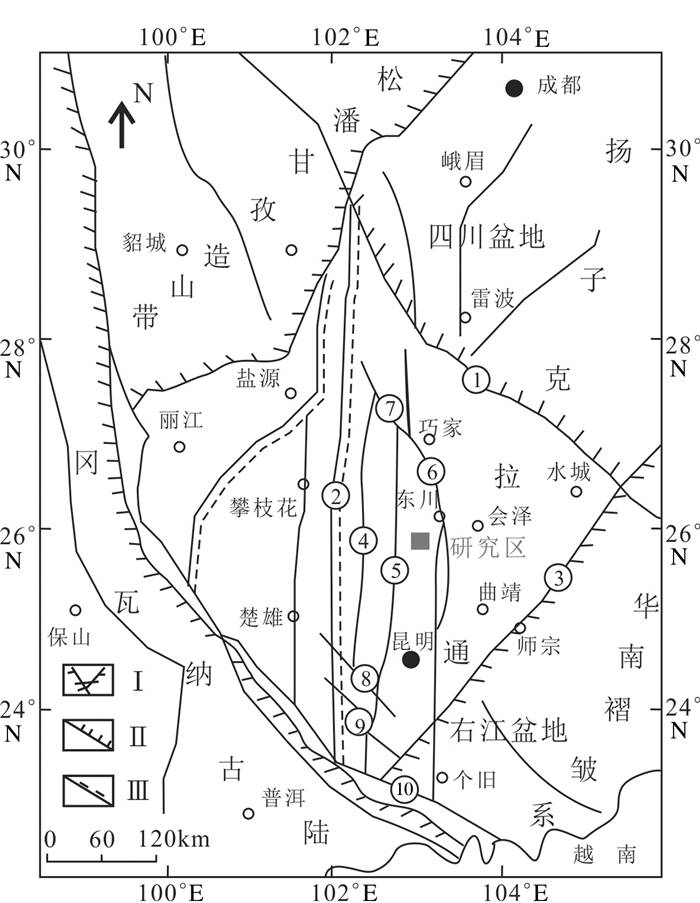
 下载:
下载:
